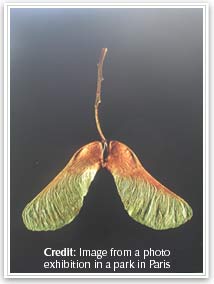Archive page - Service no longer offered
This website began in the summer of 2003 and so has seen much content over time. We have made a decision that, for now, rather than delete pages that are no longer being updated, or are for services that we no longer offer, we would instead place them in this archive section to serve as a portfolio, library & as a history
Woodland Management
Invasive Sycamore Control

Sycamore
Sycamore is a technically non-native, however it has been on the British Mainland for many hundreds of years. Some consider it naturalised or as good enough native, it just depends how far you go a back in time. Sycamore does support a certain amount of wildlife and can be an important timber crop. When mature in a parkland setting they are magnificant trees. It can also be coppiced and has been used in the past for making handles for tools and other woodland craft products.



Our landscape is better for the presence of Sycamore however in some situations it can become an invasive species. Sycamore seeds prolifically and these seeds self-set very easily.
In woodlands when establishing under favourable conditions it can become over dominant.
A characterisic of Sycamore is that it develops large leaves which can out shade other species, it also shade tolerant itself and grows quickly.
 |
 |
| The deep shade of a Sycamore dominated woodland | Prolific Sycamore saplings |
It coppices easily and so even cut stumps need to be treated or removed in order to prevent re-growth. Small 1-2 year old seedlings can be hand-pulled, but after this age they generally require cutting and treatment or mechanical pulling.
Becasue of Sycamore's prolific seed generation the soil contains a bank of viable seeds. Hand pulling of Seedlings may need to continue for a number of years until this is exhausted or perhaps indefinately if, as there often is, Sycamore trees growing on adjacent third party land that is not under control. The winged seed can, with the right wind conditons, travel long distances.
Thorndon Park SSSI Woodlands - Brentwood Borough Council
Thorndon Park, Brentwood, Essex contains large semi-natural ancient woodlands.
Some areas of Thorndon Park, in the ownership of the local authority Brentwood Borough Council, had become dominated by Sycamore which had become invasive.
  |
Control had been started by local volunteer groups but it became clear that the scale and the ability of Sycamore to re-grow meant that professional management would be necessary to regain control over the area. Some of the Sycamores were large mature trees that required careful felling in areas used by the public. Volunteers could then keep on top of long-term managment of the Sycamore.
  |
This site had many management challenges; heavily-used public footpaths; roadside trees that required traffic control during their removal; areas of bluebells and other ground flora; streams and waterways; public perception and intervention and a SSSI status (Site of Special Scientific Interest), designated by Natural England, which necessitated additonal management constraints and considerations.
Also within these woodlands were areas of invasive laurel, in some cases these had become large specimens also requiring careful felling.
Once the trees and saplings were cut the stumps required herbicidal treatment. Stump grinding or other types of stump removal were not viable options due to the shear number of stumps and the sensitivity of the site and ecosystem.
Natural England gave a list of 4 herbicides approved for use as part of the woodland management of this SSSI site. In order to ensure that the best herbicide option, in our opinion, was selected for preventing the Sycamore stumps from re-growing we undertook a literature search and anaylsis of available scientific evidence and data for each of the 4 herbicideas sanctioned for use by Natural England. A comparative study was written up for the company policies (a copy is available to interested parties upon request). Our study looked at degredation in terms of half-life within the environment of each herbicide. The potential transportation through the environment in the ground water and from there its potential toxicity in the aquatic environment. The published toxicity towards invertebrates, insects, mammals and humans was also compared.
The selected herbicide mimics the action of the plant hormone Auxin, one if's actions is to supress the growth of latent buds. Auxin is secreted naturally by the terminal buds of branches which is the trees method of ensuring that branch growth tends outwards and hence towards light. This herbicide gives the plant a massive overdose of an auxin-like chemical which supresses the growth of latent buds in the stump. It has a markedly low toxicity in the aquatic environment as well as to invertebrates, insects, mammals and humans. It also has a low ground water movement potential. It is worth noting that this herbicide comes commonly in two different chemical forms (as two different salts). One of the forms was comparably much much more toxic and travelled in ground water readily. So our study into the 4 herbicide options was a worthy exercise.



In order to mark which stumps had been treated we added red food colouring to the herbicide. Each stump was carefully treated with a fine spray so as to minimise leakage into the surrounding environment. The treatment was very successful with a near 100% success rate.

